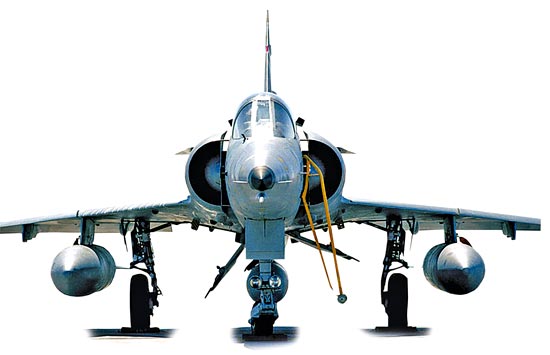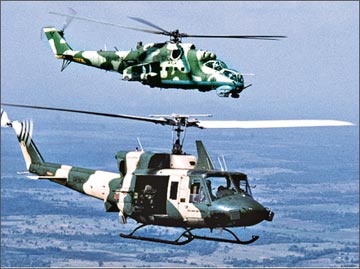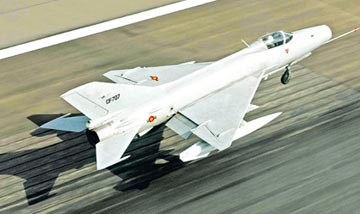The wing that saved the nation
By Dhaneshi YATAWARA
Their eagle eyes watched every movement of the enemy. Be it the
unmanned surveillance aircraft or the beech-craft with the team of
battle hardened officers and airmen, they became sharp for their
 flying
fighter aircraft and to Sri Lanka Army’s ground troops. They became the
warriors of the Sri Lanka Air Force defeating the world’s most ruthless
terrorist organisation. flying
fighter aircraft and to Sri Lanka Army’s ground troops. They became the
warriors of the Sri Lanka Air Force defeating the world’s most ruthless
terrorist organisation.
The decision taken by President Mahinda Rajapaksa to strengthen the
Air Force gave them confidence perform the best of their skills in the
air and on the ground. The Air Force was thrust into attack and was
stretched to its limit to cope during the unrest in the Northern and the
Eastern areas of the island. They transported the injured and looked
into their requirements playing a pivotal role in the fight against
terrorism.
Air sorties carried out by the SLAF fighter jets, more than 400
during the Eastern and the Northern conflict, evidently proved the high
level of professionalism, accuracy and precise targeting skills of this
valiant group of men.
Under the Command of the Air Chief Marshal Roshan Goonetileke,
Commander of the SLAF, the secret of the success is the unbeatable
teamwork. The vision of its great leader and his innovative and correct
thinking made the SLAF run in this momentum. For the Air Force
protecting the motherland is the first priority.
An Air Force depends very much on its technology. When it comes to
strategies, skills of the people become an important factor. The SLAF
independently manoeuvred the surveillance according to the security
requirements. The beech-craft and the UAVs were on surveillance for 6-7
hours at a stretch. Whenever, there was an emergency call from the Army
or the Navy they were ready to provide assistance without any delay.
The MI24 aircraft squadron provided support for the advancing troops
to break the enemy line. The MiG, Kfir and F7 squadrons caused damage to
the LTTE’s Sea Tiger bases and other build ups plus the heavy gun
positions. This definitely weakened the LTTE’s fire power to a great
extent. Their operations were a typical. The outside world hear only the
results not the damage or how it attacked the enemy. The hardcore
fighters behind the scene and their stories of bravery hardly come into
limelight. What matters most is the job done well. If the mission fails,
ultimate consequence would be nothing else but death as there is no
escape if the aircraft or the pilot gets hit by enemy attacks.
The Kfirs with their formidable firepower and accuracy were able to
destroy and neutralise the strong strategic locations and artillery
positions of the LTTE. To be a Kfir pilot is really laborious. From
basic pilot training to the advanced and then MiGs will give the green
light for a SLAF pilot to handle a Kfir. It requires high expertise to
control and maintain this “Lion Cub”. Pilots are fired upon most of the
time when they carry out their missions. Lots of hardships are braved by
them solely due to their understanding of the need of the hour. With the
versatile nature of the aircraft and the expertise of the pilots the
Kfir squadron will have a major role to play in any situation.
 The battle tank of the Air Force, the MI24 helicopter squadron,
played a crucial role in breaking enemy lines and supporting the rapidly
advancing ground troops. Their duty is to break the LTTE strength and
power directly penetrating into the enemy terrains. They crossed the
enemy line into LTTE area. When a helicopter is flying low it does not
move fast and become an easy target to the enemy. The strength of the
MI-24 its massive fire power and its launching capability within a short
period of time terrorizing the enemy. The pilots of the MI-24 squadron
carried out attacks in all the frontlines in a day and broke positions
of the entire enemy line. Until the LTTE were extremely cornered MI-24s
continuously faced severe hits from the enemy on each mission. The battle tank of the Air Force, the MI24 helicopter squadron,
played a crucial role in breaking enemy lines and supporting the rapidly
advancing ground troops. Their duty is to break the LTTE strength and
power directly penetrating into the enemy terrains. They crossed the
enemy line into LTTE area. When a helicopter is flying low it does not
move fast and become an easy target to the enemy. The strength of the
MI-24 its massive fire power and its launching capability within a short
period of time terrorizing the enemy. The pilots of the MI-24 squadron
carried out attacks in all the frontlines in a day and broke positions
of the entire enemy line. Until the LTTE were extremely cornered MI-24s
continuously faced severe hits from the enemy on each mission.
The MiG-27 is well-known for its skills in launching attacks. Though
their counterparts in many advanced countries are reluctant to undertake
such risks. MiGs served as the best weapon for surprise attacks. The MIG
squadron is the first to start night time flying. According to aircraft
experts of the SLAF, the MiG-27 had better technology to carry out night
time flying. The SLAF started their night time flying way ahead of the
so-called LTTE air capability. According to experts, before the MIG-27
came into operation the fighter jets had to orbit around the target
making their operation obvious to the LTTE cadres who went into hiding
escaping the attack. With its capability to attack at low level, the
MiGs undertook successful missions both independently and jointly. The
MiGs have the capability to carry more ammunition and explosives and
still attack the targets successfully and return safely.
MiGs-27 played a crucial part in destroying the LTTE sea power in the
seas off Mullaitivu. The small attack craft of the LTTE targeted the Sri
Lanka Navy boats on patrol and vanished into their hideouts. The
surveillance provided by the UAVs and the beech-craft helped identify
the Farah III ship’s wreckage as the LTTE hideout.
On November 2, 2007 the Air Force made a historic attack creating a
turning point in the Eelam War IV. A Kfir and a MiG-27 aimed at a prime
target of the LTTE, its Political Wing Leader S. P. Thamilselvan. This
was a severe blow to the LTTE which became a turning point in their
downfall. This crucial attack made history in the two fighter jet
squadrons.
Purchased first in 1991 from China the F7 squadron started its
mission mainly as an air interceptor with the F7 BS type of aircraft.
This has the capacity of ground attacks. The turning point for the
squadron was the first LTTE air attack on March 26, 2007. The Air Force
was equipped with the F7 GS - the type with air to air interceptor
capabilities. Their basic duty was to destroy the enemy aircraft. This
was a unique situation for the Air Force since nowhere in the world any
other Air Force had to face this type of enemy threat from air. Their
first success was destroying LTTE aircraft over Iranapalai. They had to
fly like LTTE air craft in pitch dark and as low as 500 metres above the
ground. It needed great expertise and fortunately the Air Force had
pilots of that capacity.
The F7 has the capability to scan, detect an unidentified aircraft
and to guide it to the nearest air field if it responds positively. If
it does not obey and move towards a specific target the F7s launch the
attack.
The F7, on many occasions have supported the Army as well as the Navy
during their operations.
Saving soldiers and civilians
 Be it in the middle of the night or during a stormy weather the Bell
212 squadron keep themselves ready for casualty or troop evacuations or
for transportation of troops. Bell 212s are accompanied by the MI24
helicopters during the evacuation missions when the Army troops were
trapped inside enemy terrain. This is the squadron which was involved in
evacuating a Sri Lanka Army Special Forces Long Range Reconnaissance
Patrol from Oddusudan general area where Major Lalith Jayasinghe was
killed during their mission. Exceeding 5,000 flying hours and lifting
and transporting tons of cargo and thousands of injured soldiers, the MI
17 has made an outstanding job in silent manner. Be it in the middle of the night or during a stormy weather the Bell
212 squadron keep themselves ready for casualty or troop evacuations or
for transportation of troops. Bell 212s are accompanied by the MI24
helicopters during the evacuation missions when the Army troops were
trapped inside enemy terrain. This is the squadron which was involved in
evacuating a Sri Lanka Army Special Forces Long Range Reconnaissance
Patrol from Oddusudan general area where Major Lalith Jayasinghe was
killed during their mission. Exceeding 5,000 flying hours and lifting
and transporting tons of cargo and thousands of injured soldiers, the MI
17 has made an outstanding job in silent manner.
Troop movements, casualty transportation and moving Army’s Air Mobile
brigades increased immensely during the recent operations and it was
their duty to meet the demand. It was crucial. To visualize the gravity
of their responsibility their first mission in this Wanni operation
would be adequate. In it the squadron had to move 500 officers and
soldiers of the Army’s Air Mobile Brigade using six MI 17 helicopters
where one could only carry 30 fully equipped personnel. Professionalism
of pilots, including the capabilities of the technicians perform the
tough job throughout the day without facing any threats from the enemy.
Not just technology
It is the responsibility of the technicians to ensure that a pilot
could take off and return safely after successfully fulfilling his
mission.
They work round the clock to keep the engines running. The technical
staff keeps the aircraft ready for the mission. It needs continuous work
from these engineers and technicians during tight operations and when an
emergency call comes the pilot has to move in a few minutes and the time
left for the technician is counted in seconds. Adhering to the norms and
conditions of maintaining and servicing an aircraft, which are of the
international level, meeting the demand from the need of the hour was no
easy task. At times to repair a damaged aircraft these engineers and
technicians work 3-4 days continuously.
In operations, precision doesn’t rely on the technology alone. The
eyes and brains controlling the machine have a greater commitment. The
machine can only guide the pilot with correct data input. Accuracy of
the target greatly depends on the expertise of the man behind the
machine - the pilot. Every mission was equally daring for them. Be it
either close air support, dropping bombs on targets causing maximum
attrition to the enemy or evacuating injured Army personnel, they were
clear targets of the enemy. The great warriors of the Sri Lanka Air
Force were not ready to compromise the sovereignty of the country and
their wings will protect the country and its people for ever. |

